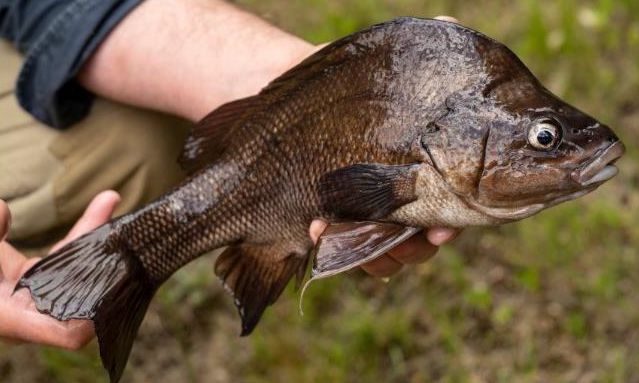Macquarie perch recovery - let's get serious about the recovery of Maccas
 The VFA, under the Freshwater Fisheries Management Plan, has a commitment to the recovery of our freshwater fish species. Now is the critical moment to secure the survival of Maccas. The VFA is working with partners right across the Murray Darling Basin using an integrated approach to make this a reality. Only by working together can we safeguard the future of this unique and iconic species
The VFA, under the Freshwater Fisheries Management Plan, has a commitment to the recovery of our freshwater fish species. Now is the critical moment to secure the survival of Maccas. The VFA is working with partners right across the Murray Darling Basin using an integrated approach to make this a reality. Only by working together can we safeguard the future of this unique and iconic species
Historically, Macquarie perch Macquaria australasica (‘Maccas’) were once an abundant and widespread native fish species throughout the south-eastern Murray-Darling system. However, Maccas are now nationally endangered and are fighting for their survival, with serious implications for Australia’s freshwater biodiversity. Australia-wide only a handful of self-sustaining wild Macca populations remain in isolated and disconnected waterways.
The Victorian Fisheries Authority, together with key partners, have worked hard over a number of years to rebuild and re-establish Macquarie perch populations. We’ve invested significant resources into production and stocking, habitat restoration, and research to better understand the species.
 However, a number of barriers and challenges to the recovery of Maccas remain.
However, a number of barriers and challenges to the recovery of Maccas remain.
The VFA in conjunction with key partners getting serious about the recovery of Maccas and are embarking on a holistic and integrated approach.
What’s New for Maccas?
Cracking the Code
After extensive efforts to build up awareness and commitment for Macquarie perch recovery amongst recreational fishers, agencies and research organisations, the VFA has been successful in obtaining a $3.7 million 3-year research program from the Fisheries Research and Development Corporation (FRDC) to finally Crack the Code on the captive breeding of Macquarie perch. For the first time, this project will coordinate investment and research into Macquarie Perch from 15 contributing partners, including:
- Victorian, NSW and ACT Government agencies
- Deakin University
- University of Sunshine Coast
- Monash University
- University of Melbourne
- The Arthur Rylah Institute
- Norwegian Institute of Aquaculture Research
- North East and Goulburn Broken Catchment Management Authorities
- Recreational Fishers across Victoria and New South Wales.
This landmark project will focus a spotlight on everything that is required to breed Maccas in captivity, particularly: hormone and nutrition optimisation, a coordinated hatchery breeding manual and genetic analysis of captive bred and wild fish.
We need Maccas to thrive, not just survive, and this project will be a huge leap towards this goal.
For more information on captive breeding of Macca’s please watch this short film on Cracking the Code:
New Fisheries Notice: Macquarie perch are now fully protected
Up until recently, Macquarie perch have had a limited recreational fishery in only two waters in Victoria, the Upper Coliban Reservoir and Lake Dartmouth. In recognition of the continued decline of Maccas, their endangered status and the preciousness of all fish that remain in these waters (particularly Lake Dartmouth, the largest remnant population of Macquarie perch), the VFA has now fully prohibited recreational fishing for Macquarie perch anywhere in Victoria.
This move has been welcomed by recreational fishers and all other stakeholders as a crucial step towards not only protecting what we have left, but also recovering this iconic native fish to the prominent place that it once held in the Murray Darling Basin’s fisheries.
What else is happening for Maccas?
There’s plenty happening for the recovery of Macquarie perch! Check out the following links to just some of the other projects happening to save Macquarie Perch:
New South Wales Fisheries: Bring Back the Mack!
Macquarie perch display at Melbourne Aquarium
The VFA have partnered with the SEA LIFE Melbourne Aquarium to create a Macquarie perch display that opened in August 2022, featuring adult Macquarie perch transported from the Snobs Creek hatchery, near Eildon.
The display will help raise awareness about this endangered native fish and the collaborative efforts underway to accelerate its recovery in the wild.
Fisheries Management Actions
Fish breeding, stocking and translocation
There are a range of complementary and integrated actions for supporting the recovery of Maccas. Captive breeding and stocking of Macquarie perch has been identified as the most critical action and short-term goal for their recovery.
A recent episode of the VFA's Poddy Mullet podcast discusses the work going into recovering Maccas. Click the link below, or find The Poddy Mullet via your podcast platform.
Breeding using wild broodstock has a long history and has been undertaken over a number of years with some success.
Watch a historical video from the 1950s on Macquarie perch spawning and breeding using broodstock from the Jamieson River here:
Stocking and translocations has proven successful in re-establishing Maccas in a number of locations, such as the Ovens River.
Watch a video on the collaborative Ovens project here:
However, with our reliance on using wild broodstock for breeding limited, captive breeding is the ultimate goal if we are to give Maccas the best chance of surviving and thriving in the wild.
Stocking can also assist existing populations becoming more resilient. Fragmented Macquarie perch populations means that genetic diversity can be reduced. Most remaining populations of Macquarie perch have a low genetic diversity, and their relatively small population sizes are below what is required to keep adaptive potential (Pavlova et al 2017). Regular small-scale translocations between populations, smart stocking and increasing connectivity between populations has been recommended to improve gene flow.
Habitat and river health restoration
Macquarie perch are challenged on many fronts. The construction of dams, weirs and road crossing creates barriers to fish movement to gain access to breeding areas, better habitat or to other perch populations. Regulated rivers have dams that can discharge cold water which may disrupt temperature cues for spawning. The clearing of streamside vegetation and in the catchment in general, increases erosion and siltation, resulting in the loss of deep pool habitat and smothering cobble bed spawning habitat and eggs. Other stressors including pollution from domestic, agricultural and industrial sources, introduced disease, overharvest from fishing, and competition with introduced species compound the pressures and lessen the population’s ability to cope with extreme events such as bushfire, drought or floods occur.
Stream restoration is a powerful conservation action to promote resilience to such events. Both riparian and catchment revegetation helps stabilise banks, increases food, limits erosion and helps to restore the instream habitat required by the perch. In stream actions, such as resnagging and erosion control structures, add habitat complexity to the system which increases available habitat, as well as providing more space for populations to grow. These actions can also assist in stream physical attributes-- such as buffering water temperature, increasing microhabitat structure and therefore increase availability of macroinvertebrates and increase food production.
Managing environmental water, where available, can restore seasonal flow patterns and assist in spawning and recruitment.
Population monitoring and modelling
Population models can give insights into how populations can react to certain scenarios and which conservation efforts could be most useful. A model for Macquarie Perch was developed to explore scenarios for translocation and provide insights into the timeframes and what age and numbers are required for successful establishment of new populations. This model suggested combinations of young and older fish decreases the number of yearlings required and increases the chance of success under more stressful scenarios. Stocking is a viable addition in this multi-pronged approach (Todd and Lintermans 2015).
Threats to Macquarie perch
Maccas are a nationally endangered species. Once widespread throughout the south-eastern Murray-Darling system, fragmented populations are now only found in a number of isolated waterways (see a map of historical versus current distribution here).
Key threats to the survival of the species include:
- Loss of connectivity and barriers to fish passage as a result of water regulation (construction of dams, weirs)
- Changes in natural flows and cold-water impacts
- Loss of habitat, riparian vegetation and impacts on river health
- Climate change and extreme weather events (such as drought and bushfires)
Further resources
- Hunt, T.L., Douglas, J.W., Allen, M.S., Gwinn, D.C., Tonkin, Z., Lyon, J. and Pickworth, A. (2011) Evaluation of population decline and fishing sustainability of the endangered Australian freshwater fish Macquaria australasica. Fisheries Management and Ecology 18(6): 513-520
- Pavlova ,A., Beheregaray, L.B., Coleman, R., Gilligan, D., Harrisson, K.A., Ingram, B.A., Kearns, J., Lamb, A.M., Lintermans, M., Lyon, J., Nguyen, T.T.T., Sasaki, M., Tonkin. Z., Yen, J.D.L. and Sunnucks, P. (2017) Severe consequences of habitat fragmentation on genetic diversity of an endangered Australian freshwater fish: a call for assisted gene flow. Evolutionary Applications 10(6): 531-550
- Todd, C.R. and Lintermans, M. (2015) Who do you move? A stochastic population model to guide translocation strategies for an endangered freshwater fish in south-eastern Australia. Ecological Modelling 311: 63-72
For further information, please contact:
Taylor Hunt, Freshwater Fisheries Manager:
0418 478 028
Andrew Briggs, Senior Project Manager:
0427 018 406

